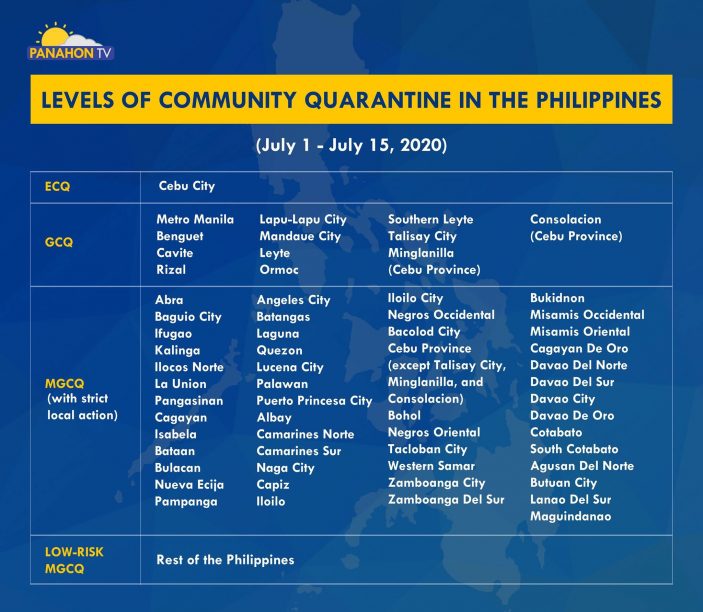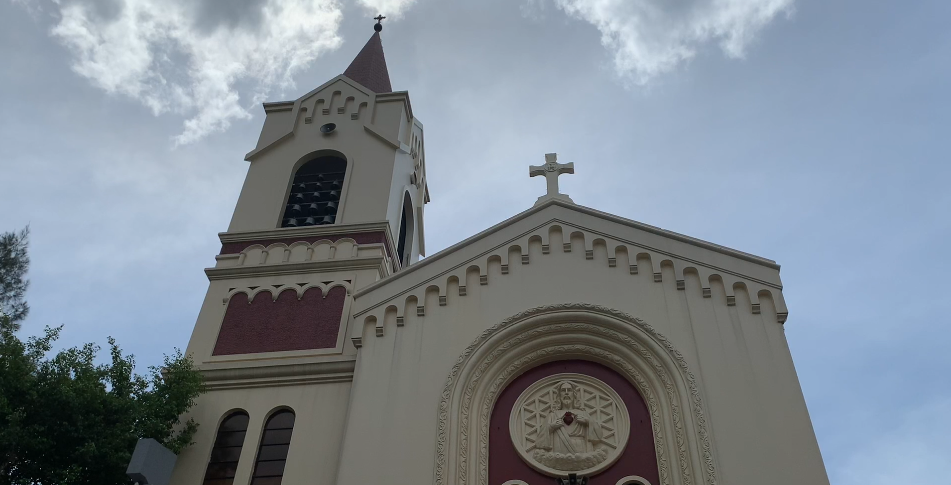The government eased restrictions in places of worship in areas under Modified General Community Quarantine (MGCQ).
Religious services in these places of worship have been allowed up to 50% of the venue’s capacity, and are subject to the government’s minimum health standards. This new rule was announced last June 3, 2020 after the government’s Inter-Agency Task Force on Emerging Infectious Diseases (IATF-EID) revised its guidelines.
On June 30, 2020, President Rodrigo Duterte announced the latest areas placed under the different levels of community quarantine.

The government previously disallowed religious gatherings during the Enhanced Community Quarantine (ECQ), and allowed places of worship to accept only a maximum of 10 participants in areas under General Community Quarantine (GCQ).
In a statement, the Catholic Bishops’ Conference of the Philippines welcomed the government’s 50% capacity rule.
 Sacred Heart Parish-Shrine in Quezon City
Sacred Heart Parish-Shrine in Quezon City
The Sacred Heart Parish-Shrine in Quezon City introduced protocols to ensure the safety of its parishioners once the city is placed under MGCQ. To find out how this church is readying for the resumption of religious gatherings, watch this report: http://shorturl.at/oCUXY
Kathy San Gabriel | Panahon TV Reporter

Hallyu, a Chinese word that literally translates to “Korean Wave”, is used to describe the growing awareness and appreciation of South Korean culture across the globe. From music and television dramas, to cuisine and cosmetics, Korean influences are everywhere—even in our country where one can definitely feel hallyu.
For most fans of Korean culture, the ultimate way to experience it is in its motherland. But if the price of a plane ticket to your dream country is too steep for your taste, try going to Bulacan to get a piece of Korea.
In Bocaue, Bulacan, the Shrine of Saint Andrew Kim Taegon is making waves in social media.
This Catholic church’s original structure was built in 1959, and on its 50th year in 2009, was renovated under the leadership of Father Avel Sampana, former parish priest of the church. The architecture is breathtaking, with touches of gold and white that add to its serenity. Every part of the shrine has a significant meaning to the life of St. Andrew.
Outside, plants abound, a refreshing break from the urban concrete. This shrine has many sections, such as the room for St. Andrew’s Relic, which houses a small piece of bone from the saint, which is said to be miraculous.
You’ll also find a gazebo facing the Sta. Maria River, its bamboo-covered, meandering pathways symbolizing the journey of St. Andrew from South Korea to the Philippines. A pagoda representing the seven sacraments is a peaceful spot for reflection. Mango trees abound in the area because St. Andrew loved writing beneath their shade.
During your stroll, you will also chance upon the statue of Saint Andrew Kim. Considered the first Korean Catholic priest, Saint Andrew actually lived in Bulacan to study Catholicism back in the 18th century. Back then, Catholics in Korea were persecuted by the ruling Joseon Dynasty for abandoning Confucianism. After serving as a seminarian in Bocaue, he became a priest. He went back to his own country to spread the word of God, but was caught and sentenced to death. On May 6, 1984, Pope John Paul II led his canonization.
To reach the shrine, ride the German Espiritu bus located in SM North or the RJ Bus in Monumento bound for Balagtas, Bulacan. After getting down at 7-11 Bocaue, ride a jeepney bound for Marilao. Ask the driver to drop you off at Mc Donald’s Lolomboy. From there, take a 300-meter walk.


Things to remember when visiting:
*Remember that this tourist destination is primarily a church. The Korean nuns and devotees would appreciate your silence and compliance to rules.
*You may want to wear you best OOTDs for your Instagram posts, but make sure your clothes are decent. No sleeveless, no shorts or short skirts. Wear proper footwear.
*Just like in other places, clean as you go.
The shrine is open from 10:00 am to 12:00 noon and 2:00 pm to 4:00 pm. Masses are held from 6:30 am every 1st Saturday of the month.
Panahon TV Intern Charlene Bianes
